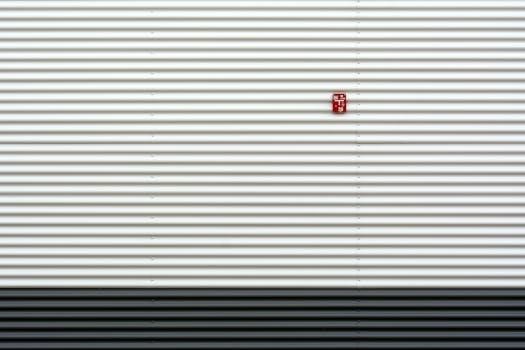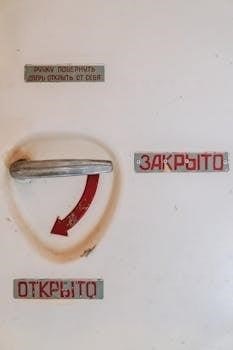Roll Up Door Installation⁚ A Comprehensive Guide
This guide provides detailed instructions for installing roll-up doors‚ emphasizing safety and accuracy․ It covers crucial steps‚ from initial measurements to final adjustments․ Proper installation is essential for optimal door performance and longevity․ Always consult the manufacturer’s instructions and employ qualified technicians․
Safety Precautions and Required Expertise
Installing roll-up doors demands strict adherence to safety protocols and requires specialized expertise․ This is not a DIY project for the inexperienced․ Due to the weight and tension involved‚ improper handling can lead to severe injuries․ Therefore‚ engaging trained rolling door technicians is paramount․ These professionals possess the necessary skills‚ knowledge‚ and tools to safely and effectively install roll-up doors․
Before commencing any installation work‚ thoroughly review all manufacturer’s instructions‚ warnings‚ cautions‚ and notes․ Familiarize yourself with the specific door model and its unique installation requirements․ Ensure that the work area is clear of obstructions and potential hazards․ Wear appropriate personal protective equipment (PPE)‚ including safety glasses‚ gloves‚ and sturdy footwear․ Never attempt to install a roll-up door alone; always have a competent assistant present․
Working with tension springs and heavy components requires extreme caution․ If you lack the necessary training and experience‚ do not attempt to handle these parts․ Contact a qualified technician immediately․ Ignoring these safety precautions can result in serious accidents and property damage․ Remember‚ safety should always be the top priority during roll-up door installation․
Essential Tools and Equipment for Installation
Successful roll-up door installation hinges on having the right tools and equipment readily available․ Attempting the job with inadequate or inappropriate tools can compromise safety and the quality of the installation․ A comprehensive toolkit is‚ therefore‚ indispensable․

Essential hand tools include a measuring tape (preferably a long one for accurate opening measurements)‚ a level (both standard and a long level for aligning tracks)‚ a square‚ various wrenches (including adjustable wrenches and socket sets)‚ screwdrivers (Phillips head and flathead in multiple sizes)‚ a hammer‚ and pliers․ A drill with various drill bits is also necessary for creating pilot holes and securing fasteners․
Power tools that significantly aid the process include a power drill‚ an impact driver (for efficiently driving screws)‚ and a metal-cutting saw (for trimming tracks if necessary)․ Safety glasses‚ work gloves‚ and a hard hat are crucial personal protective equipment․ Lifting equipment‚ such as a forklift or hoist‚ may be required for handling heavier doors․ Finally‚ ensure you have an ample supply of appropriate fasteners‚ including screws‚ bolts‚ and anchors‚ as specified by the manufacturer’s instructions․ Having all these tools on hand will streamline the installation process and ensure a secure and professional result․
Measuring the Opening⁚ Ensuring Accurate Dimensions
Accurate measurement is the cornerstone of a successful roll-up door installation․ Precise dimensions ensure a proper fit‚ smooth operation‚ and prevent potential issues down the line․ Neglecting this step can lead to costly rework and compromise the door’s functionality and security․

Begin by measuring the width of the opening at the top‚ middle‚ and bottom․ Use the narrowest measurement as your final width․ Next‚ measure the height from the floor to the top of the opening on both sides․ Again‚ use the shorter measurement as your final height․ It’s crucial to account for any existing structures or obstructions within the opening that might affect the door’s clearance․
Also‚ measure the headroom – the distance from the top of the opening to the lowest obstruction above‚ such as pipes or beams․ Sufficient headroom is necessary to accommodate the rolled-up door curtain and its operating mechanism․ Finally‚ measure the sidelap‚ which is the distance from the edge of the opening to any side obstructions․ This measurement ensures the door has enough space to slide smoothly within the guides․ Record all measurements clearly and double-check them before proceeding to the next stage of installation․ Accurate dimensions are paramount for a seamless and efficient roll-up door installation․
Pre-Installation Steps⁚ Preparing the Door and Components
Before commencing the physical installation of the roll-up door‚ thorough preparation is crucial for a smooth and efficient process․ This involves carefully inspecting all components‚ ensuring you have the necessary tools‚ and preparing the opening for installation․ Neglecting these pre-installation steps can lead to delays‚ damage‚ and potential safety hazards․
Begin by unpacking all the components and meticulously comparing them against the parts list provided in the installation manual․ Check for any shipping damage‚ such as dents‚ scratches‚ or missing parts․ Report any discrepancies to the supplier immediately․ Next‚ organize the components for easy access during the installation process․ This includes separating the door curtain‚ mounting brackets‚ guides‚ hardware‚ and any optional accessories․
Carefully examine the door curtain for any defects or damage․ Ensure the slats are properly aligned and the endlocks are securely fastened․ Clean the installation area and ensure it is free from obstructions․ Verify that the opening is properly framed and structurally sound․ Reinforce the opening if necessary to provide adequate support for the door․ Finally‚ gather all the required tools‚ including measuring tapes‚ levels‚ drills‚ wrenches‚ and safety equipment․ Proper preparation will streamline the installation process and minimize potential problems․
Mounting Plate and Bottom Sill Installation
The mounting plate and bottom sill installation forms the foundation for a secure and properly functioning roll-up door․ Accurate placement and secure fastening are paramount to ensure the door operates smoothly and withstands environmental stresses․ Any errors in this stage can compromise the entire installation․
Begin by precisely positioning the mounting plates according to the manufacturer’s specifications․ Use a level to ensure the plates are perfectly vertical and aligned with each other․ Mark the mounting holes on the wall or structure‚ ensuring they are centered and equidistant from the opening․ Drill pilot holes and securely fasten the mounting plates using appropriate fasteners‚ such as lag bolts or concrete anchors‚ depending on the wall material․ Verify that the plates are firmly attached and can support the weight of the door assembly․
Next‚ install the bottom sill‚ ensuring it is level and flush with the floor․ The bottom sill provides a smooth surface for the door to seal against and prevents debris from entering the opening․ Secure the bottom sill using appropriate fasteners‚ ensuring it is firmly anchored to the floor․ Apply a weather sealant along the bottom sill to create a watertight seal․ Double-check all measurements and alignments before proceeding to the next step․ This meticulous approach ensures a solid and reliable foundation for the roll-up door installation․
Positioning and Securing the Door Assembly
Positioning and securing the door assembly is a critical step in the roll-up door installation process․ It requires careful attention to alignment‚ balance‚ and secure fastening to ensure the door operates smoothly and safely․ Any misalignment or improper securing can lead to operational issues and potential hazards․
Begin by carefully lifting the door assembly into position‚ aligning it with the previously installed mounting plates․ Use appropriate lifting equipment‚ such as a forklift with padded forks‚ to prevent damage to the door curtain․ Ensure the door is centered within the opening and that the torsion pole is properly seated on the mounting plates․ Once the door is in position‚ temporarily secure it with clamps or supports to prevent it from shifting during the fastening process․
Next‚ securely fasten the door assembly to the mounting plates using U-bolts or other specified hardware․ Tighten the fasteners evenly‚ ensuring the door remains aligned and balanced․ Double-check all connections to confirm they are properly secured and can withstand the forces exerted during door operation․ Remove the temporary supports and carefully test the door’s balance․ Make any necessary adjustments to ensure the door rolls up and down smoothly without binding or excessive friction․ This meticulous approach guarantees a stable and properly secured door assembly․
Tensioning the Roll-Up Door
Tensioning the roll-up door is a crucial step that directly impacts its smooth operation and longevity․ Improper tension can lead to difficulties in opening and closing‚ premature wear‚ and potential safety hazards․ This process requires careful attention and adherence to the manufacturer’s instructions․
Begin by ensuring the door curtain is fully and evenly wound around the roll․ With the curtain secured‚ carefully wind the torsion spring a specified number of turns‚ typically towards the wall․ The exact number of turns depends on the door’s height and weight‚ so consult the manufacturer’s guidelines for precise instructions․ Use appropriate tools and techniques to maintain control during the tensioning process‚ as the spring can exert considerable force․
Once the spring is tensioned‚ securely lock it in place․ Test the door’s balance by manually lifting it partially and observing its movement․ The door should remain stationary‚ indicating proper tension․ If the door drifts upwards or downwards‚ adjust the tension accordingly‚ adding or subtracting turns as needed․ Ensure the tension is evenly distributed across the spring to prevent uneven wear․ After achieving the correct tension‚ perform a full operational test‚ opening and closing the door several times to confirm smooth and consistent performance․ A properly tensioned door will operate effortlessly and safely․
Guide Installation and Adjustment
The proper installation and adjustment of the door guides are critical for ensuring the smooth and safe operation of a roll-up door․ These guides‚ typically mounted vertically on either side of the opening‚ ensure that the door curtain travels smoothly and remains aligned during operation․ Misaligned or improperly installed guides can lead to binding‚ friction‚ and potential damage to the door curtain․
Begin by carefully positioning the guides according to the manufacturer’s specifications‚ ensuring they are plumb and parallel to each other․ Securely fasten the guides to the wall using appropriate hardware‚ taking into account the wall’s material and the door’s weight․ After installation‚ perform a visual inspection to confirm the guides are straight and free from any obstructions․
Adjustment is key to achieving optimal performance․ The door curtain should move freely within the guides without excessive play or binding․ If necessary‚ adjust the guides by loosening the mounting hardware and shifting them slightly until the door operates smoothly․ Lubricating the guide runners with silicone spray can further reduce friction and improve performance․ Regularly inspect the guides for wear and tear‚ and promptly address any issues to prevent damage and maintain smooth operation․ Properly installed and adjusted guides contribute significantly to the door’s longevity and reliability․
Connecting to Fire Door Closing Systems (If Applicable)
When installing fire-rated roll-up doors‚ integrating them with fire door closing systems is paramount for automatic protection during fire events․ These systems are designed to automatically close the door upon detection of smoke or heat‚ compartmentalizing the fire and preventing its spread․ The connection process requires meticulous attention to detail and adherence to local fire safety codes․

First‚ ensure that the fire door closing system is compatible with the specific roll-up door model․ Consult the manufacturer’s documentation for approved systems and connection guidelines․ Typically‚ the connection involves wiring the door’s release mechanism to the fire alarm panel or a dedicated smoke/heat detector․ This wiring must be done by a qualified electrician‚ following all relevant electrical codes․
After the physical connection‚ rigorously test the system to verify its functionality․ Simulate a fire alarm condition to ensure the door closes promptly and completely․ Pay close attention to the closing speed and ensure it meets safety standards․ Regularly inspect and maintain the fire door closing system to guarantee its reliability․ This includes checking the wiring‚ sensors‚ and release mechanism․ Proper connection and maintenance of the fire door closing system are crucial for life safety and property protection․
Adjustments and Troubleshooting
After installation‚ fine-tuning your roll-up door is crucial for smooth operation and longevity; Adjustment procedures typically involve tweaking the spring tension‚ guide alignment‚ and limit switches․ If the door is too difficult to open or closes too quickly‚ the spring tension likely needs adjustment․ Refer to the manufacturer’s instructions for the proper method to increase or decrease tension‚ usually involving winding or unwinding the torsion spring․
Misalignment of the guides can cause the door to bind or operate unevenly․ Ensure the guides are plumb and parallel‚ adjusting them as needed to provide a smooth track for the door curtain․ Limit switches control the upper and lower travel limits of the door․ If the door doesn’t fully open or close‚ or if it reverses unexpectedly‚ adjust the limit switches accordingly‚ following the manufacturer’s guidelines․
Troubleshooting common issues involves systematic diagnosis․ If the door is noisy‚ lubricate the moving parts‚ including the rollers‚ hinges‚ and guides․ If the door is difficult to operate manually‚ check for obstructions or binding in the track․ If the motor is malfunctioning‚ inspect the wiring‚ fuses‚ and motor components․ Always disconnect power before performing any electrical troubleshooting․ Consult a qualified technician for complex repairs or if you are uncomfortable working with electrical components․
Maintenance and Lubrication
Regular maintenance and lubrication are vital to ensure the long-term smooth operation of your roll-up door․ A consistent maintenance schedule can prevent costly repairs and extend the lifespan of the door․ Start by visually inspecting all components‚ including the curtain‚ guides‚ rollers‚ and hardware‚ for signs of wear‚ damage‚ or corrosion․ Address any issues promptly to prevent them from escalating․
Lubrication is key to minimizing friction and wear․ Apply a high-quality silicone-based lubricant to all moving parts‚ such as the rollers‚ hinges‚ and guides․ Avoid using petroleum-based lubricants‚ as they can attract dirt and debris‚ causing premature wear․ Lubricate the torsion spring regularly to prevent rust and ensure smooth operation․ Check the tension of the spring periodically and adjust as needed to maintain proper balance․
Clean the door curtain regularly to remove dirt‚ dust‚ and grime․ Use a mild detergent and water solution‚ and avoid abrasive cleaners that can damage the finish․ Inspect the weather stripping for damage and replace it as needed to maintain a tight seal․ Regularly test the door’s operation to identify any potential problems early on․ By following a consistent maintenance and lubrication schedule‚ you can keep your roll-up door operating smoothly and reliably for years to come․
Post-Installation Inspection Checklist
After completing the installation of your roll-up door‚ a thorough post-installation inspection is crucial to ensure proper functionality and safety․ Begin by verifying that all components are securely fastened and aligned correctly․ Check the mounting plates‚ bottom sill‚ guides‚ and tensioning mechanisms to confirm they are firmly in place and meet the manufacturer’s specifications․ Ensure all bolts and screws are tightened to the appropriate torque․

Next‚ test the door’s operation by opening and closing it several times․ Observe the movement for any signs of binding‚ unevenness‚ or excessive noise․ The door should roll up and down smoothly without requiring excessive force․ Verify that the locking mechanism engages properly and secures the door effectively․ Inspect the weather stripping to ensure it creates a tight seal when the door is closed․
Examine the tension of the spring system to confirm it is properly adjusted․ The door should remain stationary at any point in its travel without drifting up or down․ If applicable‚ test the functionality of any fire door closing systems to ensure they activate correctly in the event of a fire․ Finally‚ review the installation manual to confirm that all steps have been completed and documented․ Addressing any deficiencies identified during the inspection will ensure the long-term reliability and safety of your roll-up door․
